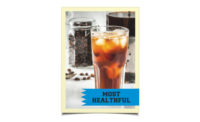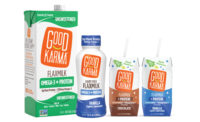Sparkling water continues to shine in the nondairy beverage category. In its March 2013 “Bottled Water – US” report, Mintel noted that the segment grew 16.3% in 2011 and 34% in 2012, and will continue its growth through 2017.
“The segment offers a closer parity for consumers looking to trade away from carbonated soft drinks [CSDs] or other high-sugar drinks due to the carbonation and frequently low calorie count,” the Chicago-based market research firm reported.
Although private label remains the leader of the segment, individual brands also have showcased strong performance, including Preston, Wash.-based TalkingRain’s Sparkling Ice, which increased sales approximately 134% for the 52 weeks ended Aug. 11, 2013 according to data from IRI, Chicago. The sparkling water brand continues to roll out new flavors, such as its Crisp Apple, Strawberry Lemonade, and Lemonade and Tea.
Atlanta-based The Coca-Cola Co.’s Glacéau brand released Fruitwater, a naturally fruit-flavored, zero-calorie sparkling water. Packaged in a 16.9-ounce bottle, Fruitwater is available in five varieties — Black Raspberry, Orange Mango, Watermelon Punch, Strawberry Kiwi and Lemon-Lime — and is sweetened with sucralose.
But industry veterans aren’t the only ones contributing to the segment. Los Angeles-based Atom Factory has Pop Water, designed to offer a compromise between carbonated soft drinks and water, the company said. Available in Apple, Orange, Pineapple and Grape flavors, Pop Water is sweetened with sugar, erythritol and stevia rebaudiana leaf extract.
While not growing as fast as sparkling, bottled water has remained stable. Jeffrey Cohen, industry analyst for IBISWorld, Santa Monica, Calif., notes that the market research firm has identified four factors contributing to the category’s overall stability.
“Some of the driving forces that we identified were demand from supermarkets and grocery stores; per capita disposable income; the price of the input into bottled water production, which is plastic materials and resin; and the healthy eating index,” he said.
Chicago-based Mintel forecasts that bottled water will continue its modest increases through 2017 and will attain sales of $15.5 billion.
Although private label brands fared better during the recession, Cohen said the bottled water category continues to see dominance from three major players — Nestlé Waters North America, Stamford, Conn.; The Coca-Cola Co.; and Purchase, N.Y.-based PepsiCo. Accounting for 75% of the market, the companies’ brands have outperformed private label and are expected to continue this trend, he adds.
Function and flavor
“It’s definitely a much smaller category as a whole than still, sparkling and jug, but we’ve actually seen more of a shift toward enhanced and flavored water over the last five years,” Cohen said.
The Coca-Cola Co.’s Smartwater, which goes through a vapor distilling process and features added electrolytes, saw sales increase approximately 16% for the 52-week period ended Aug. 11, 2013. Bothell, Wash.-based Essentia’s same-named brand has seen its sales increase 50% each year for the last three years, said President and Chief Executive Officer Ken Uptain. The brand removes acidic ions to reach a pH of 9.5.
Brands also are finding new ways to deliver nutritional benefits, such as through dispensing caps. Karma Culture’s Karma Wellness Water; H2M Beverages’ 989 On Demand, New York Spring Water’s VBlast and The Rising Beverage Co.’s Activate brands all feature vitamins and minerals within the cap that are added to the water at the time of consumption.
Utilizing its patented twist cap, VBlast launched three new functional waters: Refresh, Antioxidant and Immunity. VBlast Refresh contains choline, vitamin E and zinc; VBlast Antioxidant features grape seed extract, vitamin C, vitamin E and tea polyphenols; and VBlast Immunity contains echinacea, vitamin C, elderberry extract and zinc gluconate.
Beyond new releases, brands also are launching marketing campaigns touting the benefits of the delayed vitamin and mineral addition. Los Angeles-based Activate Drinks campaign last summer titled “Stop Vitamin Cruelty” highlighted the company’s vitamin efficacy message. The campaign, which is designed like a public service announcement, featured a 30-second digital spot exposing vitamin characters slowly deteriorating in water, adding a humorous element to Activate’s primary benefit of preserving nutrients in the cap, the company said.
Euromonitor’s Jonas Feliciano explained that enhanced waters benefit from offering a closer drinking experience to that of CSDs with their functionality and taste components.
“With these flavored waters and these functional waters, those types of things are speaking toward consumers that are more conscious of health. The other side of that is flavor variety,” Feliciano said.
The beverage maker blk. Beverages LLC, Hoboken, N.J., has four flavors of its fulvic-acid-enhanced mineral water: Black Lemonade, Mango Splash, Tropical Punch and Blueberry Acai.
Something for the kids
Companies also are putting an emphasis on children in their product development and marketing initiatives.
“I think it’s a way to introduce and to give parents an alternative to the soft drinks that they’re packing in their students’ lunch pails and lunch bags,” Feliciano said.
New York Spring Water sells a line of zero-calorie functional waters called Vbee!. Also using the company’s patented twist-cap technology, VBee! beverages blend spring water with vitamins and calcium. The brand is available in Blue Raspberry, Watermelon and Green Apple flavors and features a cartoon bee on the label.
Also utilizing kid-friendly characters, Irvine, Calif.-based True Drinks Inc.’s AquaBall features recognizable characters on its naturally flavored enhanced waters that contain vitamins B3, B5, B6, B12 and C. The company also has a licensing agreement with Marvel to display certain super hero characters.
The water category as a whole should benefit from such initiatives as Drink Up, launched by the Washington, D.C.-based nonprofit Partnership for a Healthier America (PHA) and its honorary chair first lady Michelle Obama. The campaign, through its public- and private-sector partners, will encourage consumers to drink more water by utilizing a number of different platforms..
Through the partnership, brands will carry the Drink Up logo on nearly 300 million packs of bottled water, more than half a billion bottles of water, 200,000 packages of reusable bottles, and more than 10,000 reusable bottles.
Teas go light on sweeteners
In the ready-to-drink (RTD) tea segment, consumers are trending toward lightly sweetened beverages, according to Euromonitor’s Feliciano. For example, Plano, Texas-based Dr Pepper Snapple Group launched Snapple Peach Passionfruit and Cherry Pomegranate Lightly Sweetened teas last summer. These all-natural white teas are sweetened with sugar and contain 80 calories in each 16-ounce bottle.
Unsweetened teas also are attractive to consumers because they often do not contain any calories, according to Euromonitor’s report, “RTD Tea in the US.” In line with this, Brooklyn, N.Y.-based Runa Tea recently added two unsweetened flavors to its zero-calorie line of guayusa teas: lime and guava.
Consumers also are drawn to RTD teas that offer all-natural attributes because of the perceived health benefits associated with natural ingredients. According to data from Mintel, 59% of consumers say the “all-natural” label is a factor in selecting an RTD tea, and 58% say the use of sugar in the beverages’ formulations influences their choices.
Overall, RTD teas make up nearly 75% of the entire U.S. tea market, according to IBISWorld. Even though tea drinkers are almost twice as likely to buy tea bags or loose-leaf tea compared with RTD tea, RTD tea is a higher-margin product and, therefore, commands greater share of the market value, according to Mintel. In addition, RTD tea sales increased approximately 7% to $4.8 billion in value in off-premise retail channels since 2012, Euromonitor’s Feliciano added.
Information in this article first appeared in the October and May issues of Beverage Industry, a BNP Media publication (like Dairy Foods). It was reported and written by BI’s Jennifer Haderspeck and Jessica Jacobsen and edited by Dairy Foods Contributing Editor April Miller.
Consider the power of cherries
As consumers’ taste preferences shift away from intensely sweet and toward tarter flavor profiles, experts say cherries have an opportunity to fill the gap.
“There’s a real trend in foodservice as well as retail grocery toward more of a sweet, tart taste than just intensely sweet taste,” said Jeff Manning, chief marketing officer of the Cherry Marketing Institute, Lansing, Mich.
Tart cherries, also known as red sour pie (RSP) cherries, have become more popular in recent years due to new evidence and awareness of their health benefits, said Greg Kaiser, president of San Dimas, Calif.-based Encore Fruit Marketing Inc., which offers purees, puree concentrates, not-from-concentrate juices and juice concentrates for both tart and dark, sweet cherries.
“Considering their histories and consumer preferences, I see the RSP-type cherry as having more upside growth potential due to its perceived health benefits,” Kaiser said.
Research has shown that tart cherries have a high level of melatonin and aid in muscle recovery, said Jim Bryant, vice president of the ingredients division of Traverse City, Mich.-based Cherry Central Cooperative Inc., which offers Montmorency tart cherry concentrates and purees.
Alexander G. Schauss, senior research director of natural and medicinal products research for AIBMR Life Sciences Inc., Puyallup, Wash., noted that consumption of tart cherry juice might lower the risk of cardiovascular disease, age-related cognitive impairment and certain cancers, according to a study published in The Journal of Nutrition in 2009.
Additionally, cherries add value to products, the Cherry Marketing Institute’s Manning added. Encore Fruit Marketing’s Kaiser added that tart cherries blend well with juices like cranberry juice, while dark, sweet cherries work well with juices like blueberry.
“It is a nice option to have two different types of cherry for flavor blending and still keep cherry on the label as an ingredient,” Kaiser said.
— By Stephanie Cernivec, Beverage Industry. Excerpted from “Taking the sour with the sweet,” May 2013
Nondairy protein beverages have broad demographic appeal
Just as sports drinks are popular among non-athlete consumers for their flavor, protein drinks also are popular among this consumer group for their flavors and convenience, said Chris Schmidt, U.S. consumer health analyst for Euromonitor.
“What draws consumers to [protein drinks] is the huge sort of overlying general health and fitness association that protein has really taken on over the last couple of years,” he said.
Protein drinks have been promoted in both workout magazines and general magazines as products that promote both muscle mass and satiety, he said. In fact, most sales for protein drinks come from mass channels, like drug stores, convenience stores, grocery stores and mass merchandisers, which further shows their success among general consumers, Schmidt pointed out. Specialty stores are even limiting their ready-to-drink (RTD) protein drink offerings because their consumers are more interested in bulk powders, he added.
According to IBISWorld’s November 2011 report, “Meal Replacement Product Manufacturing in the US,” sales of RTD protein drinks are growing in popularity among time-crunched Americans who can use it as a quick meal replacement as well as among consumers who are looking to improve their diets and lose weight.
Joe Sammarco, vice president of sales for Advanced Nutrient Science International, Largo, Fla., said that although the company’s Xtreme Shock, Protein Ice and Flurry Protein Shake lines are designed for the serious athlete, the crossover to the mainstream consumer is very common.
“With today’s busy lifestyle, consumers are demanding convenience and flexibility when it comes to nutritional choices,” he said. “RTDs continue to gain popularity with busy executives, parents and seniors. Students use them as a breakfast on-the-go, athletes use them for muscle building and recovery, and seniors use them for general maintenance.”
Other protein drink companies have expanded their target audience to include general consumers because of this trend.
“We know that protein is important for everyone, so we designed FitPro for everyone,” said Brad Kloss, founder and chief executive officer of FitPro, a brand of Sartell, Minn.-based ProClaim Nutrition LLC.
— By Jennifer Haderspeck. Excerpted from Beverage Industry, May 2013.








